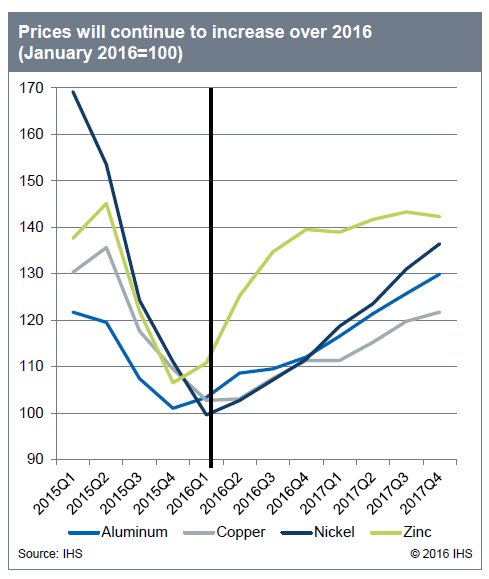Prices

March 16, 2016
Base Metals to Remain Lower than 2014 Levels
Written by Sandy Williams
Base metals are set to increase in 2016 but will be below levels seen at the end of 2014, said Frank Hoffman, IHS senior economist during the IHS First Quarter 2016 Pricing and Purchasing webinar. Production cuts and inventory dynamics along with benign global growth will keep metals prices from rebounding higher.

Nickel, used in stainless steels, has potential to see one of the biggest price increases. Currently 70 percent of the market is under water, said Hoffman. Production costs are greater than current price and thus unsustainable. Inventories dwarf nickel supply right now, said Hoffman, and aren’t providing much pressure to push up prices. Production cuts are inevitable and will erode supply and put upward pressure on pricing. IHS expects prices will rebound over the next two years.
Aluminum prices are unsustainably low said Hoffman. Production cuts will foster increases, but where they come from will determine how much prices will rise. One of the places it needs to happen is in China. Another looming issue, said Hoffman, is inventory. So far inventory is bloated and will cut into a rebound in prices. Contributing to bloat is the spread between 12 month futures price for aluminum and aluminum spot price. For inventory pricing to be profitable, said Hoffman, the spread needs to be about $80 per tonne. The spreads have been coming down, rendering financing deals unprofitable. This will lead to unwinding in inventory and a tighter market which will foster price increases going forward. Hoffman expects 2017 levels will still be below what was seen at the end of 2014.
NOTE: John Anton, IHS Global Insight Director of Steel Analysis, will once again join Timna Tanners, the #1 rated metals and mining analyst for Bank of America Merrill Lynch as they forecast steel, scrap and commodity input pricing for 2017 at our 6th Steel Summit Conference on August 29-31, 2016 in Atlanta, Georgia. Details and registration can be found on our website: www.SteelMarketUpdate.com







